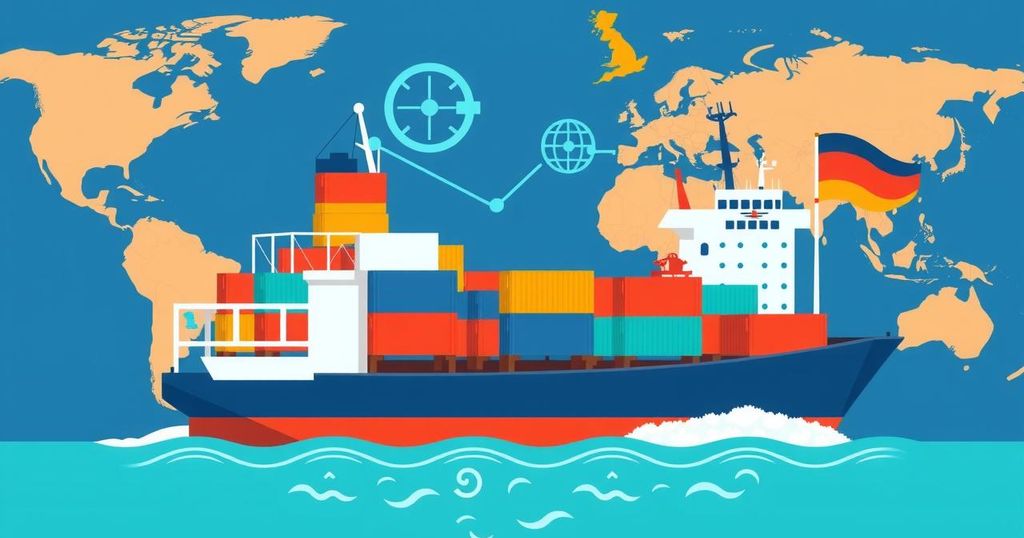Impact of Trump’s Tariffs on China’s Economy: A Heightened Challenge
The latest tariffs on China, totaling 54%, may lead to a GDP growth reduction of 2.4% by 2025. Economists predict severe indirect trade effects and potential stimulus measures from Beijing. The situation is notably more complex than during the first trade war, with significant implications for China’s economy and global trade.
Recent tariff increases instituted by Donald Trump pose a significant threat to China’s economy, likely exceeding the impact of the first trade conflict. The 54 percent tariffs announced since the onset of Trump’s second term may reduce China’s GDP growth by 2.4 percentage points by 2025, according to Citigroup. Other economists have forecasted a decline in growth by 1 to 2 percent, amid China’s ambitious 5 percent growth target for this year.
Economists from Morgan Stanley have stated, “The US tariff shock would be significantly higher and more pervasive than 2018-19.” This is due not only to the direct effects on Chinese exports to the US but also the indirect impact from tariff increases affecting global trade with other partners. In light of this slowdown, Chinese authorities may respond with substantial stimulus measures, which could include additional government spending or liquidity support for banks.
Officials in Beijing have indicated their readiness to mitigate these external pressures, with plans to potentially roll out trillions of yuan in special sovereign bonds. Currently, there are proposals to issue 1.3 trillion yuan ($179 billion) of bonds to subsidize consumer goods, and “it would be easy for China to roll out another one to two trillion yuan special sovereign bonds if necessary,” remarked Serena Zhou from Mizuho Securities Asia.
The onset of this trade standoff occurs at a critical juncture for the Chinese economy, just as it showed signs of steadiness. Recent upgrades in GDP forecasts from numerous international banks may reverse as the impact of the tariffs becomes more apparent, particularly within the next couple of years. Economists at Citigroup have warned that the tariff effects may start manifesting in the second quarter of 2025, indicating a reduction in their GDP forecast due to the potential stimulus measures needed.
In April and July, the Politburo is expected to deliberate on economic policies, possibly signaling adjustments in response to growing concerns. Additionally, a reserve requirement ratio cut for banks could unleash further cash flow for lending or investments, a move analysts anticipate from the People’s Bank of China
Analysts from Bloomberg predict a quarter-point reduction in the reserve requirement ratio this month, with further monetary policy easing likely in May. As Zhi Xiaojia noted, “we think the probability of an RRR cut in April is rising, given the needs to inject liquidity.” In addition, China’s tariff disparities with other trading nations, such as Vietnam, may narrow, lessening the adverse effects of the tariffs as alternatives become costlier.
In conclusion, the ultimate influence of the new tariffs on China’s economy remains complex and contingent on a range of factors, including the capacity to find substitutes for affected products. As noted by Tommy Xie from Oversea-Chinese Banking Corp., “the real economic cost may depend more on substitution limits than the nominal tariff rate itself.” The evolving situation underscores the need for careful economic monitoring and responsive policymaking.
In summary, the forthcoming tariffs announced by the Trump administration are poised to exert a more severe impact on China’s economy than previous trade conflicts. With potential GDP growth reductions and necessary stimulus measures on the horizon, the Chinese government must navigate these challenges carefully. The interplay of tariffs, economic policies, and global trade dynamics will shape the future economic landscape in China significantly.
Original Source: www.business-standard.com








Post Comment